Science
(www.olympiadsuccess.com)
Chapter 12: Reproduction in Plants
Class VII
NCERT Questions
Question 1
Fill in the blanks: (a) Production of new individuals from the vegetative part of parent is called_____________. (b) A flower may have either male or female reproductive parts. Such a flower is called_____________. (c) The transfer of pollen grains from the anther to the stigma of the same or of another flower of the same kind is known as _____________. (d) The fusion of male and female gametes is termed as _____________. (e) Seed dispersal takes place by means of _____________, _____________ and _____________.
Answer 1
(a) Production of new individuals from the vegetative part of parent is called vegetative propagation. (b) A flower may have either male or female reproductive parts. Such a flower is called unisexual flower. (c) The transfer of pollen grains from the anther to the stigma of the same or of another flower of the same kind is known as pollination. (d) The fusion of male and female gametes is termed as fertilisation. (e) Seed dispersal takes place by means of wind, water and animal.
Question 2
Describe the different methods of asexual reproduction. Give examples.
Answer 2
The different methods of asexual reproduction:
Vegetative propagation It is a type of asexual reproduction in which new plants are produced from roots, stems, leaves and buds.
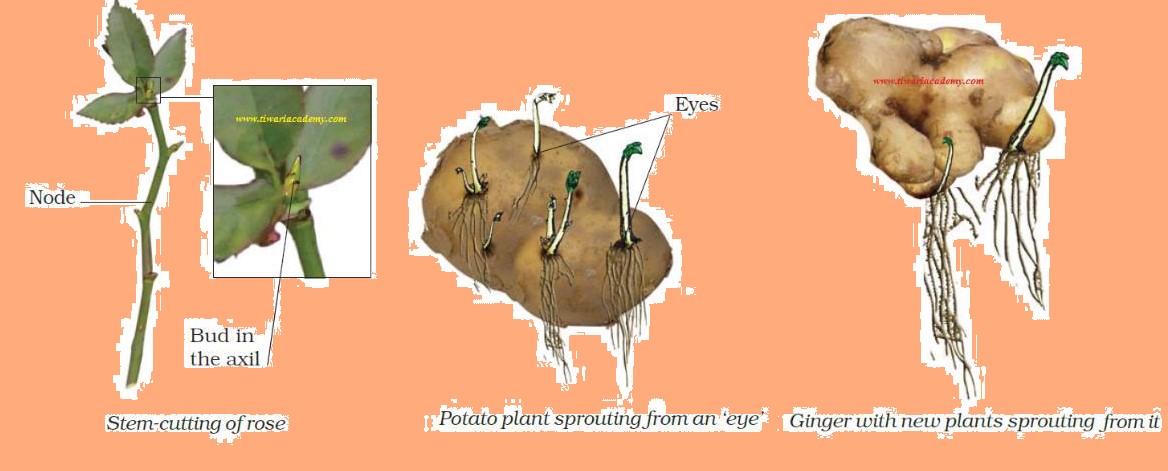
Budding Organisms such as Hydra, a bud develops as an outgrowth at one specific site. These buds develop into tiny individuals and when fully mature, detach from the parent body and become new independent individuals.
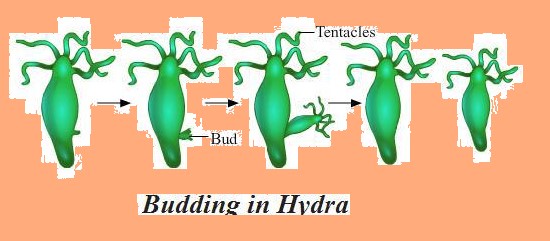
Fragmentation When water and nutrients are available algae grow and multiply rapidly and breaks up into two or more fragments. These fragments or pieces grow into new individuals.
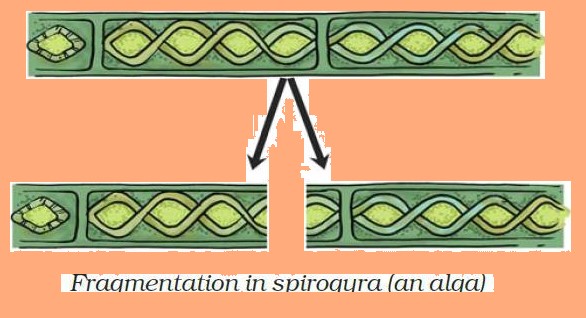
Spore formation The spores are asexual reproductive bodies. Each spore is covered by a hard protective coat to withstand unfavourable conditions such as high temperature and low humidity. So they can survive for a long time. Under favourable conditions, a spore germinates and develops into a new individual.
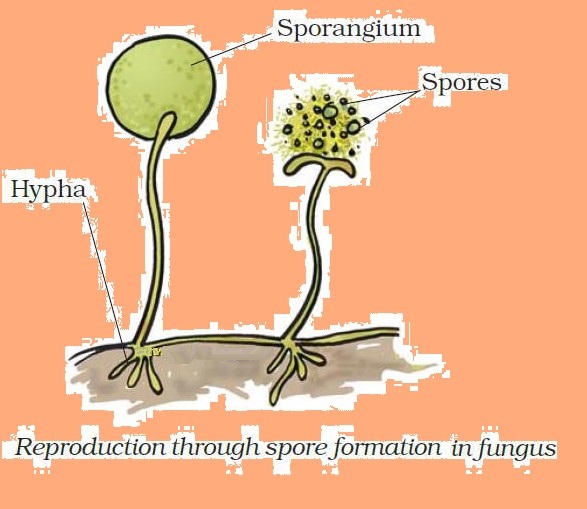
Question 3
Explain what you understand by sexual reproduction.
Answer 3
When two parents are involved in reproduction, the method is called sexual reproduction. The male and female gametes fuse during fertilization to produce zygote. The zygote subsequently develops into an embryo which further develops into a new individual.
Question 4
State the main difference between asexual and sexual reproduction.
Answer 4
gametes) are required.
respect to parent.
asexual reproduction. sexual reproduction.
Question 5
Sketch the reproductive parts of a flower.
Answer 5
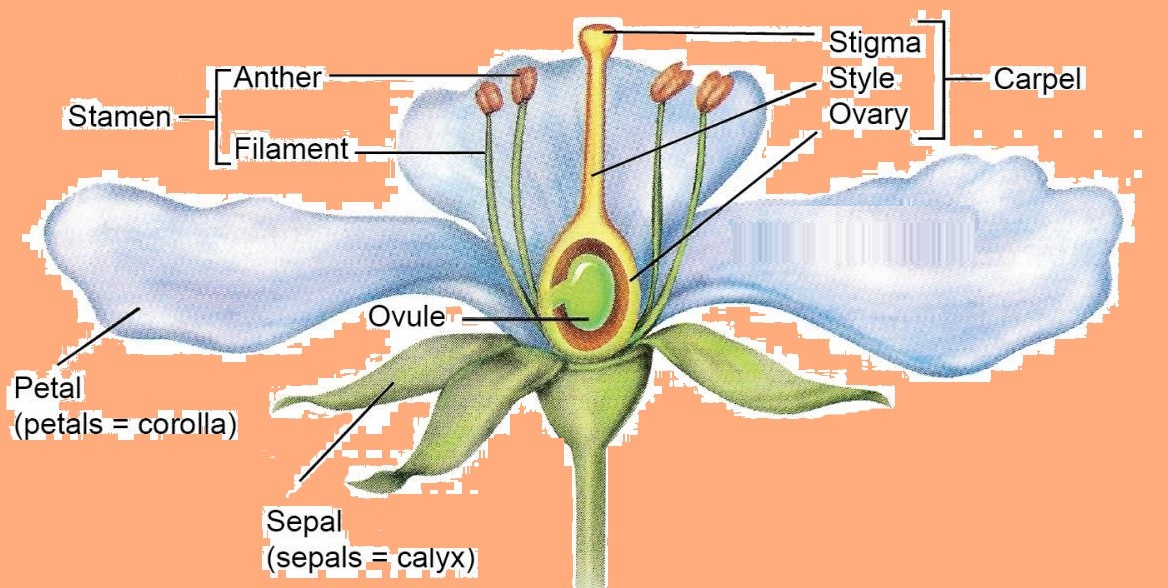
Question 6
Explain the difference between self-pollination and cross-pollination.
Answer 6
of same flower. of different flower.
insects, etc. is not required.
the flowering plants.
Question 7
How does the process of fertilisation take place in flowers?
Answer 7
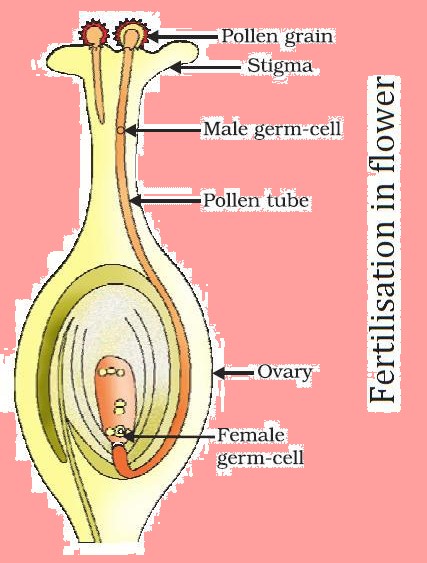
Once pollen grain spreads on the stigma, it produces a pollen tube. This process is called germination of pollen grain. The pollen tube penetrates the style and reaches the ovary. Male nucleus is transferred through this pollen tube. Finally, fusion of male and female nuclei takes place inside the ovary. This step is called fertilization.
Question 8
Describe the various ways by which seeds are dispersed.
Answer 8
Following are the various methods of seed dispersal:
Dispersal by Wind: Seeds of some plants are light-weight and some hair-like or wing-like structures are present on them. Such seeds float on air and are thus dispersed by wind. Example: Dandelion, maple, drumstick, etc.
Dispersal by Water: Dispersal by water takes place in some aquatic plants and in some which grow near a water body. Seeds of water lily float and thus dispersed by water. The coconut seed has a tough fibrous covering which has plenty of air inside. This helps the coconut seeds in floating on water.
Dispersal by Animals: Some seeds have spine like structures on them. They get stuck to the fur of animals and thus get spread to different places. Examples; Beggar tick, Xanthium, etc. Some seeds are swallowed by birds and animals along with fruits. These seeds get dispersed with bird or animal droppings.
Dispersal by Bursting: Some fruits burst open when they mature. The force of bursting is enough to spread the seeds. Examples; Ladyfinger, castor, balsam, etc.
Dispersal by Humans: Human beings also help in dispersal of seeds, especially during farming.
Question 9
Match items in Column I with those in Column II:
Column I Column II
(a) Bud (i) Maple
(b) Eyes (ii) Spirogyra
(c) Fragmentation (iii) Yeast
(d) Wings (iv) Bread mould
(e) Spores (v) Potato
(vi) Rose
Answer 9
Column I Column II
(a) Bud (iii) Yeast
(b) Eyes (v) Potato
(c) Fragmentation (ii) Spirogyra
(d) Wings (i) Maple
(e) Spores (iv) Bread mould
Question 10
Tick (√) the correct answer:
(a) The reproductive part of a plant is the (i) leaf (ii) stem (iii) root (iv) flower
(b) The process of fusion of the male and the female gametes is called
(i) fertilisation (ii) pollination (iii) reproduction (iv) seed formation
(c) Mature ovary forms the
(i) seed (ii) stamen (iii) pistil (iv) fruit
(d) A spore producing plant is
(i) rose (ii) bread mould (iii) potato (iv) ginger
(e) Bryophyllum can reproduce by its
(i) stem (ii) leaves (iii) roots (iv) flower
Answer 10
(a) The reproductive part of a plant is the (iv) flower. (b) The process of fusion of the male and the female gametes is called (i) fertilisation. (c) Mature ovary forms the (iv) fruit. (d) A spore producing plant is (ii) bread mould. (e) Bryophyllum can reproduce by its (ii) leaves.
Yearlong program for Olympiads preparation & to build necessary skills for future.
Explore More
Time to mark your calendar with the upcoming Olympiads exam schedule.
Explore More
Take your Olympiad preparation to next-level by taking LIVE Classes.
Explore More
Assess your performance by taking topic-wise and full length mock tests.
Explore More
Online tuitions for international compeitions like SASMO, SEAMO, etc for Grades 1-11.
Explore More